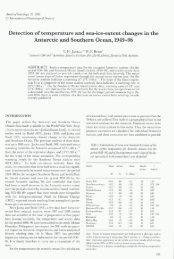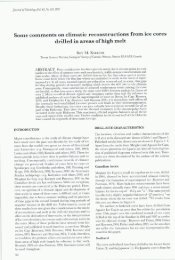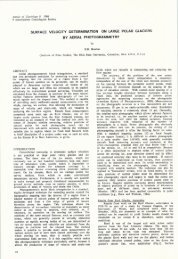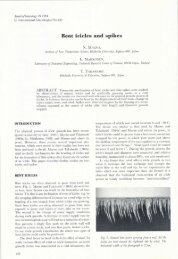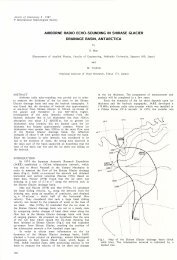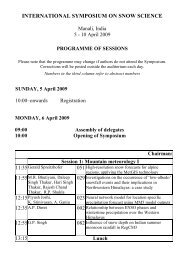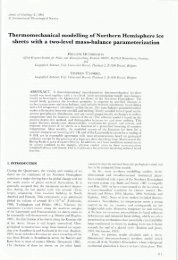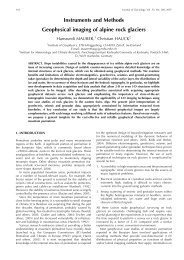143-156 - International Glaciological Society
143-156 - International Glaciological Society
143-156 - International Glaciological Society
Create successful ePaper yourself
Turn your PDF publications into a flip-book with our unique Google optimized e-Paper software.
144 JOURNAL OF GLACIOLOGY<br />
Fig. 1. Diagram of the viscometer.<br />
A cog wheel moved by a worm gear (6) is driven by an electrical motor through two gearboxes<br />
and a speed reducer. A drum made of moulded plastic (Hi) with diametricallyopposite<br />
raised obstacles simulates the bedrock, it is attached to a stationary steel hub (10).<br />
The hub transmits the torque to a calibrated steel rod (8); the opposing torques on this rod<br />
and on the worm gear balance through the U-shaped supports (7). At its upper end the hub<br />
is fastened to a flared hollow column (5) which centres the upper surface.<br />
Between the toothed annulus and the drum an ice ring is formed. Its dimensions are<br />
given in Figure 2. When the machine operates the flow is two-dimensional and the sliding<br />
on the cogs (principally by melting-refreezing) is negligible. The velocity on the bumps is<br />
100 m/year if the mobile enclosure makes one revolution in 98.5 h. Experiments were made<br />
with velocities in the range 60-1 000 m/year.<br />
Pressure control<br />
The pressurized enclosure is divided into two chambers by a base (4). The upper chamber<br />
is filled with water, the lower one with oil. The same pressure, provided by a nitrogen<br />
cylinder, is applied to the water through (17) and to the oil through (19). This arrangement<br />
was designed because the viscometer was not originally in a cold room. At that time the oil<br />
chamber was cooled and the machine was insulated with a polyurethane jacket. The main<br />
difficulties were that it was impossible to remove the ice from the viscometer at the end of<br />
an experiment, because of the delayed elastic response of bubbly ice. It was also difficult to<br />
keep both sides of the ice watertight, in order to allow the water pressure in the cavities to be<br />
independent of the confining pressure. Further, it was difficult to maintain the ice at the<br />
melting-point for a long time with only negligible melting. This problem was solved when a<br />
new building for the Laboratoire de Glaciologie was constructed in 1973. Today, with the




